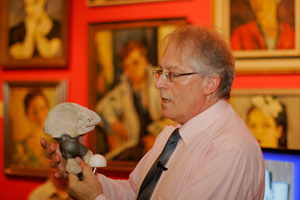X-Men bodies, Vicatos-style
19 February 2014 | Story by Newsroom
It's not quite the indestructible adamantium skeleton of Stan Lee's Wolverine character, but UCT's metal-based skeletal reconstruction technique comes as close to the stuff of science-fiction legend as anything in a comic book.
While the X-Men character's skeleton was made of the fictional metal, Dr George Vicatos prefers a titanium alloy for the 'bones' he fashions and places into patients who have lost a piece of their original foundation.
Attendants at the Café Scientifique event last month - a series of dialogues designed to bring science to the broader community - were fascinated by the innovation on display, as Vicatos demonstrated his bone replacements that are working in more than 500 patients nationally and internationally.
As space-age as the technology seems, it's not all that new.
"In about 2000 BC, an Egyptian replaced the shoulder of a patient with ivory," says Vicatos.
Vicatos is a bio-engineer and bone-implant designer based at UCT's Department of Mechanical Engineering, who says he spent many childhood hours exploring the bones of dissected animals in his mother's laboratory. This marvelling at their "magnificent" natural structure inspired Vicatos to marry his engineering skills with his interest in biology.
With the aid of 3-D printing technology, Vicatos' orthopaedics company - backed up by a team of doctors and metallurgists - designs and produces bones and parts of bones for people suffering from a variety of maladies. These include cancer patients, those suffering from traumatic injuries, and patients who have prosthetics that have "gone bad [from] inside the body, where the bone has withdrawn, and the implant is a failure," explains Vicatos.
Cancer patients are the main clients, with the bone-implants being used "one step before amputation", he says.
"I replace bone with metal," he says, with a favourite motto of his being 'Bridge the gap'! For shattered bones, replacing with metal has a number of benefits over the otherwise standard practice of inserting metal pins and screws to piece together bone fragments.
For one, patients with a titanium femur or pelvis can be up on their feet within a week or so (aided by physiotherapy), whereas screws and pins typically leave one mostly immobile for many months, with muscle tissue wasting away in the meantime.
"Mobility helps the healing process, too," says Vicatos.
So far, Vicatos has made and implanted (he gets into scrubs and assists surgeons in theatres) femurs, shoulders, humeruses, elbows and knees. These are simple enough to do, he says.
"Pelvic girdles are more challenging because of all the other soft tissue structures (like huge arteries and nerves) that are in very close proximity to the pelvis," says the engineer; in spite of this, he has successfully designed and provided custom implants for these parts.
He has also made a breakthrough on another particularly tricky area - the jaw. The mandible (lower jaw) and maxilla (upper jaw) "are where the problems start", he says. However, a semi-circular structure with a moveable carrier resembling an open hose-clamp ("nothing extraordinary from an engineering perspective") has allowed patients that are missing large parts of their upper jaws to regrow their own soft and bone tissues from gums to palates, with space for new teeth to be fitted.
In essence, the titanium structure sections off a space for new tissue to grow in. Four patients have already been treated this way, with another scheduled for later this February.
As with any invasive structure, tolerance by the receiving body is a key concern. Titanium's tendency to be readily accepted makes it the ideal element for new skeletons, says Vicatos. It's also very light - just a bit heavier than aluminium - and is flexible enough to bend with the rest of the skeleton.
And what of the cost?
The cash price for an imported scapula is around R300 000, Vicatos says, while in South Africa the locally made implant is supplied at a fraction of the cost. "My implants are covered by medical aid," he says. Patients can expect their medical aid funds to pay about R80 000 for a titanium knee or contribute towards it. Implants are quite expensive, explains Vicatos, because of the design, development, the metal itself, manufacturing, company expenses and the insurance.
Each set of hip bones, for example, need to be designed individually to cater for a patient's unique anatomy, while implants for, say, the upper arm, or for a long bone, can follow a more generic design. This is not to say that one size fits all; being modular, the 'bones' can be shortened and lengthened to requirements, and implants in children can be extended at regular intervals in proportion to the rest of the body.
As they are, the implants 'merely' perform a similar function to their predecessors, and it was a relief when a patron asked what was on many minds: would such innovations eventually begin to augment the human body's functioning, giving us, well, superpowers?
"No," chuckles Vicatos, assuring some (slightly disappointed) audience members that he had no such plans.
Not that that will bother the hundreds of patients who have - or will be given - a new lease on life from his metal 'bones'.
The next Café Scientifique takes place on 25 February at the Irma Stern Museum and features UCT's Professor Keertan Dheda, who will discuss novel ways of diagnosing tuberculosis.
Text: Yusuf Omar. Image: supplied.
 This work is licensed under a Creative Commons Attribution-NoDerivatives 4.0 International License.
This work is licensed under a Creative Commons Attribution-NoDerivatives 4.0 International License.
Please view the republishing articles page for more information.










